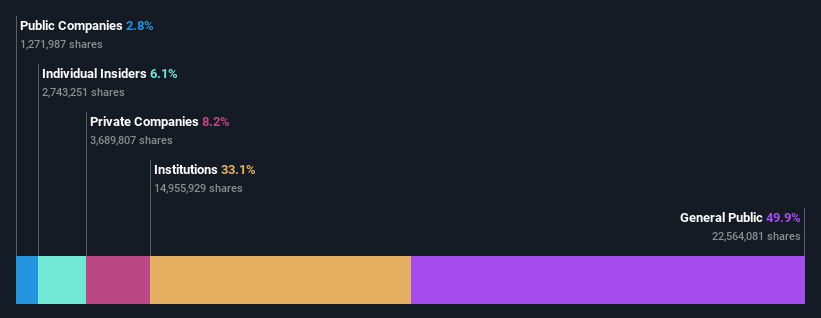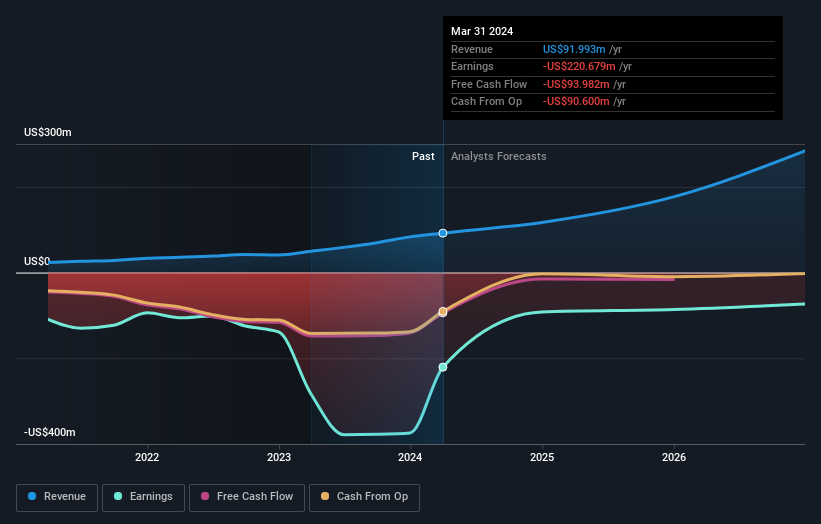Stock Analysis
Ouster, Inc.'s (NYSE:OUST) 11% loss last week hit both individual investors who own 50% as well as institutions

Key Insights
- Ouster's significant retail investors ownership suggests that the key decisions are influenced by shareholders from the larger public
- A total of 25 investors have a majority stake in the company with 42% ownership
- Insiders have been buying lately
A look at the shareholders of Ouster, Inc. (NYSE:OUST) can tell us which group is most powerful. The group holding the most number of shares in the company, around 50% to be precise, is retail investors. In other words, the group stands to gain the most (or lose the most) from their investment into the company.
Following a 11% decrease in the stock price last week, retail investors suffered the most losses, but institutions who own 33% stock also took a hit.
Let's take a closer look to see what the different types of shareholders can tell us about Ouster.
Check out our latest analysis for Ouster

What Does The Institutional Ownership Tell Us About Ouster?
Institutional investors commonly compare their own returns to the returns of a commonly followed index. So they generally do consider buying larger companies that are included in the relevant benchmark index.
Ouster already has institutions on the share registry. Indeed, they own a respectable stake in the company. This can indicate that the company has a certain degree of credibility in the investment community. However, it is best to be wary of relying on the supposed validation that comes with institutional investors. They too, get it wrong sometimes. When multiple institutions own a stock, there's always a risk that they are in a 'crowded trade'. When such a trade goes wrong, multiple parties may compete to sell stock fast. This risk is higher in a company without a history of growth. You can see Ouster's historic earnings and revenue below, but keep in mind there's always more to the story.

Ouster is not owned by hedge funds. Banyan Venture Holdings Llc is currently the largest shareholder, with 5.4% of shares outstanding. Meanwhile, the second and third largest shareholders, hold 5.1% and 4.1%, of the shares outstanding, respectively. In addition, we found that Charles Pacala, the CEO has 1.6% of the shares allocated to their name.
A deeper look at our ownership data shows that the top 25 shareholders collectively hold less than half of the register, suggesting a large group of small holders where no single shareholder has a majority.
While studying institutional ownership for a company can add value to your research, it is also a good practice to research analyst recommendations to get a deeper understand of a stock's expected performance. Quite a few analysts cover the stock, so you could look into forecast growth quite easily.
Insider Ownership Of Ouster
While the precise definition of an insider can be subjective, almost everyone considers board members to be insiders. The company management answer to the board and the latter should represent the interests of shareholders. Notably, sometimes top-level managers are on the board themselves.
Insider ownership is positive when it signals leadership are thinking like the true owners of the company. However, high insider ownership can also give immense power to a small group within the company. This can be negative in some circumstances.
Our most recent data indicates that insiders own some shares in Ouster, Inc.. As individuals, the insiders collectively own US$31m worth of the US$509m company. Some would say this shows alignment of interests between shareholders and the board. But it might be worth checking if those insiders have been selling.
General Public Ownership
With a 50% ownership, the general public, mostly comprising of individual investors, have some degree of sway over Ouster. While this size of ownership may not be enough to sway a policy decision in their favour, they can still make a collective impact on company policies.
Private Company Ownership
It seems that Private Companies own 8.2%, of the Ouster stock. Private companies may be related parties. Sometimes insiders have an interest in a public company through a holding in a private company, rather than in their own capacity as an individual. While it's hard to draw any broad stroke conclusions, it is worth noting as an area for further research.
Next Steps:
It's always worth thinking about the different groups who own shares in a company. But to understand Ouster better, we need to consider many other factors. Be aware that Ouster is showing 3 warning signs in our investment analysis , and 1 of those is potentially serious...
Ultimately the future is most important. You can access this free report on analyst forecasts for the company.
NB: Figures in this article are calculated using data from the last twelve months, which refer to the 12-month period ending on the last date of the month the financial statement is dated. This may not be consistent with full year annual report figures.
Valuation is complex, but we're helping make it simple.
Find out whether Ouster is potentially over or undervalued by checking out our comprehensive analysis, which includes fair value estimates, risks and warnings, dividends, insider transactions and financial health.
View the Free AnalysisHave feedback on this article? Concerned about the content? Get in touch with us directly. Alternatively, email editorial-team (at) simplywallst.com.
This article by Simply Wall St is general in nature. We provide commentary based on historical data and analyst forecasts only using an unbiased methodology and our articles are not intended to be financial advice. It does not constitute a recommendation to buy or sell any stock, and does not take account of your objectives, or your financial situation. We aim to bring you long-term focused analysis driven by fundamental data. Note that our analysis may not factor in the latest price-sensitive company announcements or qualitative material. Simply Wall St has no position in any stocks mentioned.
About NYSE:OUST
Ouster
Provides lidar sensors for the automotive, industrial, robotics, and smart infrastructure industries in Americas, the Asia-Pacific, Europe, the Middle East, and Africa.
Flawless balance sheet with limited growth.

